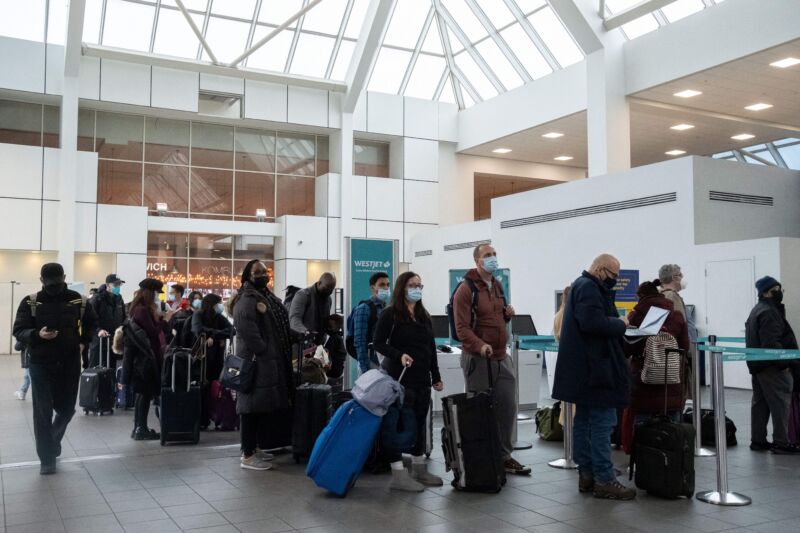
/ Travelers wait in line to check-in at LaGuardia Airport in New York, on December 24, 2021. -On Christmas Eve, airlines, struggling with the Omicron variant of Covid-19, have canceled over 2,000 flights globally, 454 of which are domestic, into or out of the US.
As the ultratransmissible omicron coronavirus variant bears down on the US, the Centers for Disease Control and Prevention on Monday made a controversial decision to ease COVID-19 isolation and quarantine rules.
The country’s omicron surge has sent graphs of case counts vertical, and is already causing severe strain on health systems, shuttering businesses, and wreaking havoc on holiday travel and festivities. The US is currently averaging over 243,000 new COVID-19 cases per day, near the country’s all-time high of an average just over 250,000 per day set in early January 2021. Still, federal officials and public health experts say this is only the beginning of omicron’s towering wave, which may not peak until next month.
The CDC’s decision Monday is intended to ease the economic burden of the skyrocketing cases and follows an accumulation of data suggesting that infectiousness tends to wane two to three days after the onset of symptoms. However, some public health experts called the new rules “reckless” for not incorporating testing requirements.
As of Monday, the CDC says that people who test positive for COVID-19 but do not develop symptoms can cut their isolation period down from 10 days to only five—though they must wear a mask for an additional five days when around others. The new guidance does not stipulate that people should test negative prior to ending isolation at the earlier time period.
“The change is motivated by science demonstrating that the majority of SARS-CoV-2 transmission occurs early in the course of illness, generally in the 1-2 days prior to onset of symptoms and the 2-3 days after,” the CDC said in its announcement.
Similarly, the CDC slashed quarantine periods for people who are unvaccinated or are vaccinated but past due for a booster dose. If someone in one of these two groups is exposed to someone with COVID-19—that is, they were within six feet of an infected person for a cumulative 15 or more minutes over a 24-hour period—they can quarantine for only five days, rather than the previous recommendation of 14 days. The exposed person must still mask for an additional five days after the quarantine period. Again, the new rule does not stipulate that an exposed person receive a negative test result to end quarantine.
A balance
The CDC did not change its guidance for people who are vaccinated and boosted or vaccinated and not yet eligible for a booster. For these groups, people do not need to quarantine after an exposure unless they develop symptoms. However, the CDC still recommends that they get tested and mask indoors.
In a statement Monday, CDC Director Dr. Rochelle Walensky called the new recommendations a “balance” between the fighting the formidable variant and keeping the country functioning. “The omicron variant is spreading quickly and has the potential to impact all facets of our society,” Walensky said. “CDC’s updated recommendations for isolation and quarantine balance what we know about the spread of the virus and the protection provided by vaccination and booster doses. These updates ensure people can safely continue their daily lives. Prevention is our best option: get vaccinated, get boosted, wear a mask in public indoor settings in areas of substantial and high community transmission, and take a test before you gather.”
The decision drew praise from businesses and industry leaders, particularly those in charge of airlines. There have been thousands of flights cancelled over the holidays due, in part, to staff shortages. Just last week, the airline trade group, Airlines for America lobbied the CDC to cut recommended isolation periods.
In a statement late Monday, Delta Air Lines welcomed the CDC’s updated guidance, saying it “allows more flexibility for Delta to schedule crews and employees to support a busy holiday travel season and a sustained return to travel by customers.”
Delta’s Chief Health Officer Dr. Henry Ting added that it “is a safe, science-based and more practical approach based on what we now know about the omicron variant.”
“Reckless”
But, while other public health experts generally agreed with Ting’s point, they were frustrated that the CDC’s new guidance did not also require negative test results. Dr. Michael Mina, a Harvard epidemiologist and long-time advocate of rapid testing, called the new guidance “reckless.”
He noted that while some people may be infectious for only three days, some may be infectious for longer periods, even up to 12 days. “I absolutely don’t want to sit next to someone who turned [positive] five days ago and hasn’t tested [negative],” Mina wrote on Twitter. Requiring a negative test result to leave isolation early is “just smart,” he concluded.
Similarly, Dr. Céline Gounder, an infectious disease expert at New York University, said on Twitter that the shortened isolation and quarantine periods are only reasonable if they’re paired with rapid testing. “People are infectious for a wide range of time. Some for a couple days. Others, for over a week,” she wrote.
Gounder and others pointed out that the CDC may not have included testing requirements in their update because the country is currently seeing shortages of rapid tests and long lines at testing centers. “CDC’s isolation policy is being driven by a scarcity of rapid antigen tests,” she concluded. But, Mina pushed back on this excuse, calling it an “artificial” problem stemming from a failure to fortify testing capacity earlier in the pandemic.